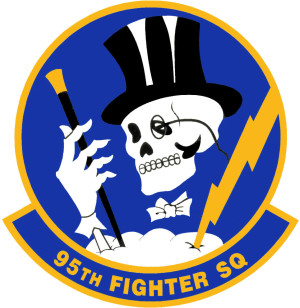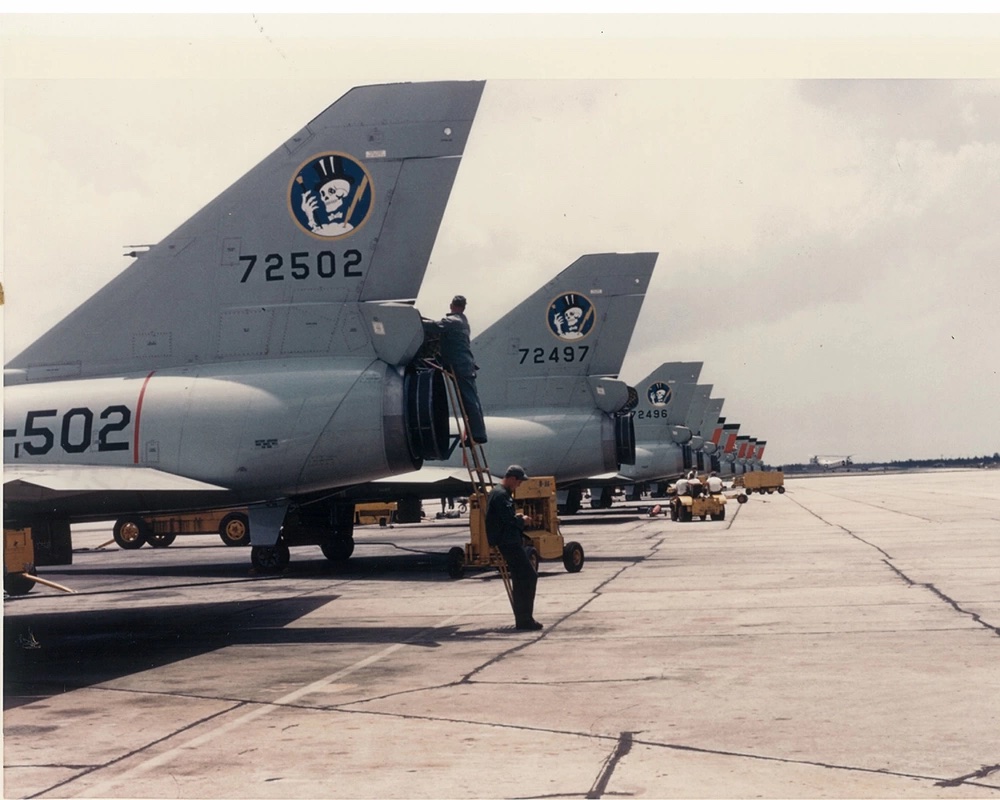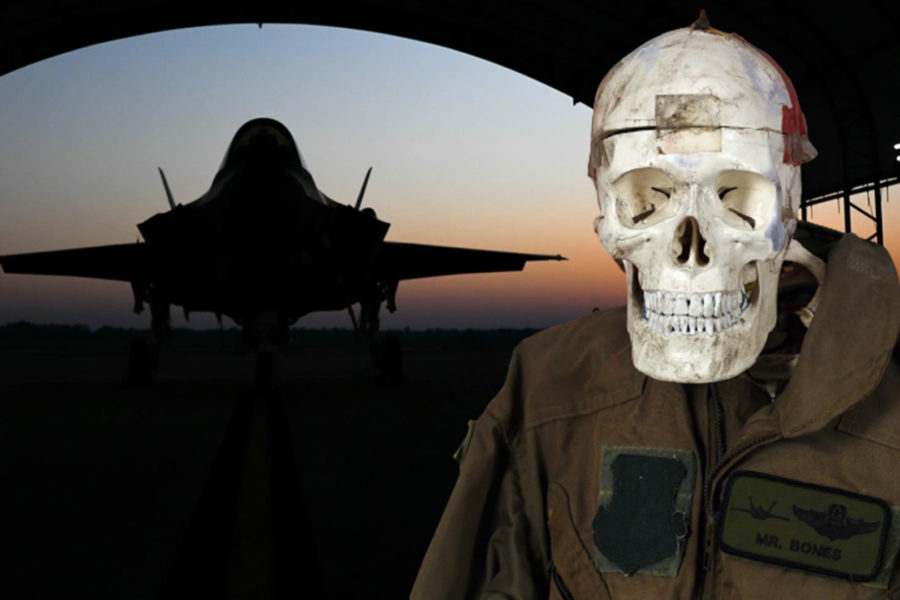It was an unusually humid day in February when Air Force Col. Chris Bergtholdt picked up a shovel at Tyndall Air Force Base, Fla., and went about a peculiar task. He and his deputy, Lt. Col. Alex Goldfein, walked together into a construction area where, at a spot marked by four posts near the intersection of two sidewalks in front of where the old 95th Fighter Squadron building once stood, they began to dig.
It did not take long to find what they were looking for—two coffins made of plywood that had rotted away in the wet, sandy dirt. Inside each coffin was a skeleton: not a real one, but a full-scale, medical school-quality imitation wearing a flight jacket.
The skeletons, both called Mr. Bones, served as mascots for the ‘Boneheads’ of the Air Force’s 95th Fighter Squadron. The first Mr. Bones was buried in 2010 when the squadron, at the time an F-15C/D training unit, was deactivated, Bergtholdt said in an interview with Air & Space Forces Magazine. Airmen bought a new Mr. Bones when the unit was reactivated as an F-22 squadron in 2013, but he too was buried in 2019 when the unit was disbanded again after Hurricane Michael devastated the base.
Four years later, the historic squadron will be reactivated as an F-35 unit this June. It will be the first of three such squadrons to stand up at Tyndall, and Mr. Bones is one of the first squadron members to return.
“There was a whole culture around Mr. Bones, kind of this aura and personality around him even though obviously it’s this inanimate object,” said Bergtholdt, commander of Tyndall’s 325th Operations Group and a former F-15 student at Tyndall’s 1st Fighter Squadron.
The arrival of the F-35 is part of a larger transformation at Tyndall, which is being rebuilt as an Installation of the Future that can stand up to future storms. But Bergtholdt didn’t want the old heritage to end up crushed under construction equipment.
“That whole area is being dug up and all of our new facilities and hangars on the flightline are being constructed at the moment, so we just didn’t want that history to be lost,” he said.
Indeed, digging up the past seems to be one of the first steps in writing a new chapter in the long story of the 95th.

‘We’re the first ones’
The two Mr. Bones now sit on a filing cabinet outside Bergtholdt’s office, where they await their incoming commander, Lt. Col. Michael Powell of Luke Air Force Base, Ariz. Powell has his hands full with not only standing up a new F-35 squadron, but doing it at an installation that has not been built yet.
“We’re the first ones, which is going to be extremely challenging, but also extremely rewarding, because we will set the pace, the cadence, the culture,” he told Air & Space Forces Magazine. “It’s so important for us to set that right.”
Powell is due to arrive at Tyndall in June, about two months before the unit’s first F-35s actually arrive. In an era where the Air Force is preparing to operate from austere locations in the Pacific Ocean, Airmen with the 95th will get an early taste at Tyndall, much of which is still under construction.
“We’re going to show that we can execute, train and be ready in kind of a more austere environment in our own base,” Powell said. “This is going to feel a little bit more like a flying exercise or a deployment where we often are hopping between a couple different buildings and temporary facilities. I think it will feel like that for a couple years, and as long as folks recognize that, then I think we can execute just fine.”
Powell is bringing in an accomplished crew to lay the groundwork. Future Boneheads include F-35 pilots with experience standing up squadrons at Eielson Air Force Base, Alaska, and RAF Lakenheath, United Kingdom; old hands from Tyndall’s F-22 days who will return as Lightning II pilots; and younger pilots who can bring fresh perspectives to the mix. Building a team from scratch is not typical for most new Air Force squadron commanders, but Powell is eager for the challenge.
“That’s what I’m really pumped about, is to build combat capability there,” he said. “Not just the iron or the jets, but building the people, the team, the mission so that we can actually go answer the callings required.”
Those callings could send members of the 95th Fighter Squadron all over the globe, where they may perform defensive counter-air, suppression of enemy air defenses, or other missions as a multirole F-35 squadron.
“We’re really the swing-role fighters here in [the continental United States],” Powell said. “If we’re called to go to the Pacific, we go. If we’re called to go to Europe, we go.”

Fighters to the Bone
When the F-35s arrive, they will be the latest in a long line of aircraft flown by the 95th Fighter Squadron stretching all the way back to Feb. 9, 1942, when the unit was first activated. Equipped with twin-tailed P-38 fighters, the squadron escorted bombers, shot down enemy fighters, and struck ground targets during World War II. In the skies above North Africa and Italy, the squadron tallied “more than 400 victories, including 199 air-to-air enemy kills, with only 19 losses,” according to one unit history. The squadron also picked up its nickname, ‘The Boneheads,’ and in 1954, its emblem of a grinning skull in a top hat was officially approved.
“Emanating from a cloud, a death’s head with an arrogant expression is symbolic of the squadron’s dauntless capability of accomplishing the mission in any weather, day or night; primarily stalking the enemy to destruction,” wrote Peter Coffman, historian for the 325th Fighter Wing. “The lightning is representative of the unit’s rapid striking power. The full dress, particularly the top hat, represents the squadron personnel’s sentiment that the unit is ‘tops.’”
Over the years, the 95th flew a range of fighters including the F-86, the F-102, and the F-106 before taking on the F-15C/D training mission from 1988 to 2010. Though it was unclear when Mr. Bones first joined the unit, the skeleton often attended parties, standing in an open coffin, and temporary duty travel. The F-15C is a single-seat aircraft, but former Bonehead and retired Lt. Col. Mark Hayes said Mr. Bones would fit in a storage bay behind the cockpit.
However, all that travel and social activity left the mascot vulnerable to theft. Hayes recalled other squadrons sending back photos of the captive skeleton enjoying life beyond Tyndall.
“We would try to get him back or pay whatever the ransom was, like a case of beer or something like that,” said Hayes, who is now an F-22 academic and simulator instructor at Tyndall. He looks forward to having his old squadron back.
“Even though it’s a different aircraft, we’ll make sure we welcome them and help them out,” he said.

‘That squadron’s nailing it’
Powell and the rest of his team will likely welcome help as they craft the framework for F-35 operations at Tyndall. They need to create a system for sharing the airspace over the Gulf of Mexico with three other Air Force bases; procure and set up ground-based targets as Tyndall shifts into a multirole mindset; and build up the right infrastructure and procedures to keep the entire operation ticking.
“I just really hope that we can do a good job of making those right the first time,” Powell said.
If it all works out, the next two F-35 squadrons can hit the ground running and just focus on their culture, manning and training plans, Powell hopes. It will take two years for the 95th to get operational, but the next squadrons should be able to reach that stage within a year. Powell’s goal is simple; Excellence will run bone-deep at the 95th.
“I want others to look and be like ‘that squadron’s nailing it, they’re excellent, they do everything the right way,’” he said. “They understand that’s the standard that comes with us. That’s what I want.”
